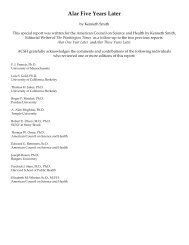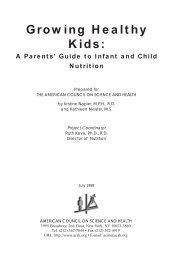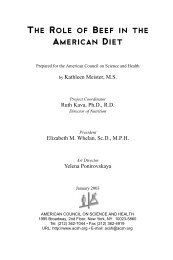Josh Bloom, Ph.D. - American Council on Science and Health
Josh Bloom, Ph.D. - American Council on Science and Health
Josh Bloom, Ph.D. - American Council on Science and Health
Create successful ePaper yourself
Turn your PDF publications into a flip-book with our unique Google optimized e-Paper software.
How the <str<strong>on</strong>g>Ph</str<strong>on</strong>g>armaceutical Industry Tamed HIV<br />
�����������������������������������<br />
�����������������������������������<br />
��������������������������<br />
stability is <strong>on</strong>e of the most carefully studied parameters<br />
in drug development.<br />
Distributi<strong>on</strong> is another important issue that needs<br />
to be addressed. Even with a suitable half-life, some<br />
drugs go to places where they are not useful, or are actually<br />
toxic. For instance, a drug required in the bloodstream<br />
(any AIDS drug) will be rendered useless if<br />
it is sequestered in the liver, muscle or fa�y tissues.<br />
Likewise, a drug used to treat central nervous system<br />
diseases must be distributed to the brain to have any<br />
utility. Distributi<strong>on</strong> is generally unpredictable <strong>and</strong> is<br />
usually studied thoroughly in animals before a drug<br />
may proceed to human trials.<br />
Excreti<strong>on</strong> is o�en related to metabolism. �e liver<br />
usually degrades a drug into smaller fragments that are<br />
excreted in the urine or feces. Sometimes the liver attaches<br />
sugar-like substances to the drug, increasing its<br />
water solubility <strong>and</strong> facilitating its transport to the kidneys<br />
where the drug is excreted. Excreti<strong>on</strong> is typically<br />
a less important issue than absorpti<strong>on</strong> or metabolism.<br />
At this point in the development process, it is still very<br />
comm<strong>on</strong> for a potent, bioavailable, stable drug to fail,<br />
despite meeting most requirements expected of a successful<br />
drug. Toxicity is by far the most comm<strong>on</strong> reas<strong>on</strong><br />
for failure.<br />
�e toxicity of a potential drug is carefully determined<br />
in a sequential process, which �rst begins in multiple<br />
cell lines, then progresses to animals <strong>and</strong> �nally<br />
c<strong>on</strong>cludes in human clinical trials. Toxicity in certain<br />
cell lines can be enough to require the cessati<strong>on</strong> of the<br />
development of a drug. Low levels of cell-based toxicity<br />
allow the drug to be evaluated in animals (usually<br />
mice <strong>and</strong> rats). Escalating doses of the drug are given<br />
19<br />
either orally <strong>and</strong>/or intravenously, <strong>and</strong> the animals<br />
are observed for signs of toxicity. Necropsy also provides<br />
important data following sacri�ce of the animal.<br />
If acceptable levels of toxicity are observed, another<br />
n<strong>on</strong>-rodent species of animal must be used (Food <strong>and</strong><br />
Drug Administrati<strong>on</strong> requirement) before any testing<br />
in humans is permissible. Eventually, escalating doses<br />
of the drug (starting with extremely small amounts)<br />
are given to healthy human volunteers, who are carefully<br />
m<strong>on</strong>itored for any sign of toxicity. �ese studies<br />
are called <str<strong>on</strong>g>Ph</str<strong>on</strong>g>ase I clinical trials. It is not uncomm<strong>on</strong> for<br />
toxicity previously unobserved in animals to show up<br />
in humans. �e predicti<strong>on</strong> of human toxicity based <strong>on</strong><br />
animal toxicity is an inexact science at best. To further<br />
complicate ma�ers, the parent drug may be n<strong>on</strong>-toxic,<br />
but <strong>on</strong>e of its metabolites may be toxic. �us, any<br />
metabolites detected in signi�cant quantity must undergo<br />
the same rigorous evaluati<strong>on</strong> as the drug itself.<br />
Following <str<strong>on</strong>g>Ph</str<strong>on</strong>g>ase I trials are <str<strong>on</strong>g>Ph</str<strong>on</strong>g>ase II trials (safety <strong>and</strong><br />
e�cacy is studies in hundreds of patients with the disease),<br />
<strong>and</strong> <str<strong>on</strong>g>Ph</str<strong>on</strong>g>ase III trials, where the drug is tested in<br />
thous<strong>and</strong>s of patients at multiple sites. If a drug clears<br />
all of these hurdles, it may be approved by the FDA<br />
<strong>and</strong> then marketed.<br />
All drugs possess some toxicity. �e important parameter<br />
is not absolute toxicity, but the ratio of toxicity<br />
to the seriousness of the disease it will be treating.<br />
For minor a�icti<strong>on</strong>s, drugs must be very safe. For lifethreatening<br />
diseases, such as cancer <strong>and</strong> AIDS, greater<br />
toxicity is permissible, since the alternative is death.<br />
N<strong>on</strong>etheless, despite the severity of the disease, the<br />
early AIDS cocktails were quite toxic <strong>and</strong> very di�cult<br />
to tolerate. Regimens involved taking multiple sets of










